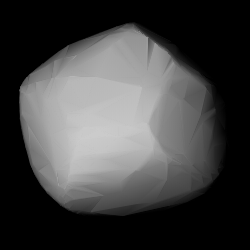Astronomy:221 Eos
 3D model based on lightcurve data | |
| Discovery | |
|---|---|
| Discovered by | Johann Palisa |
| Discovery date | 18 January 1882 |
| Designations | |
| (221) Eos | |
| Pronunciation | /ˈiːɒs/[1] |
| Named after | Eos |
| A882 BA | |
| Minor planet category | Main belt (Eos) |
| Adjectives | Eoan /iːˈoʊ.ən/[2] |
| Orbital characteristics[3] | |
| Epoch 31 July 2016 (JD 2457600.5) | |
| Uncertainty parameter 0 | |
| Observation arc | 130.21 yr (47561 d) |
| |{{{apsis}}}|helion}} | 3.3249 astronomical unit|AU (497.40 Gm) |
| |{{{apsis}}}|helion}} | 2.69594 AU (403.307 Gm) |
| 3.01044 AU (450.355 Gm) | |
| Eccentricity | 0.10447 |
| Orbital period | 5.22 yr (1907.8 d) |
| Average Orbital speed | 17.16 km/s |
| Mean anomaly | 66.5202° |
| Mean motion | 0° 11m 19.284s / day |
| Inclination | 10.880° |
| Longitude of ascending node | 141.845° |
| 193.56° | |
| Physical characteristics | |
| Dimensions | 103.87±3.6 km[3] 103.52 ± 5.60 km[4] |
| Mass | (5.87 ± 0.34) × 1018 kg[4] |
| Mean density | 10.10 ± 1.74 g/cm3[4] |
| Rotation period | 10.443 h (0.4351 d) |
| Geometric albedo | 0.1400±0.010 |
| K | |
| Absolute magnitude (H) | 7.67 |
Eos (minor planet designation: 221 Eos) is a large main-belt asteroid that was discovered by Austrian astronomer Johann Palisa on January 18, 1882, in Vienna. In 1884, it was named after Eos, the Greek goddess of the dawn, to honour the opening of a new observatory that was hoped to bring about a new dawn for Viennese astronomy.[5]
The asteroid is orbiting the Sun with a semimajor axis of 3.01 astronomical unit|AU, a period of 5.22 years, and an eccentricity of 0.1. The orbital plane is inclined by 10.9° to the plane of the ecliptic. It has a mean cross-section of 104 km,[3] and is spinning with a rotation period of 10.4 hours. Based upon its spectral characteristics, this object is classified as a K-type asteroid. The orbital properties show it to be a member of the extensive Eos asteroid family, which is named after it.[6] The spectral properties of the asteroid suggest it may have come from a partially differentiated parent body.[7]
References
- ↑ Noah Webster (1884) A Practical Dictionary of the English Language
- ↑ Eoan (3rd ed.), Oxford University Press, September 2005, http://oed.com/search?searchType=dictionary&q=Eoan (Subscription or UK public library membership required.)
- ↑ 3.0 3.1 3.2 "221 Eos". JPL Small-Body Database. NASA/Jet Propulsion Laboratory. https://ssd.jpl.nasa.gov/sbdb.cgi?sstr=221;cad=1.
- ↑ 4.0 4.1 4.2 Carry, B. (December 2012), "Density of asteroids", Planetary and Space Science 73 (1): 98–118, doi:10.1016/j.pss.2012.03.009, Bibcode: 2012P&SS...73...98C. See Table 1.
- ↑ Schmadel, Lutz (2003), Dictionary of Minor Planet Names, Springer Science & Business Media, p. 35, ISBN 9783540002383.
- ↑ Veeder, G. J. et al. (March 1995), "Eos, Koronis, and Maria family asteroids: Infrared (JHK) photometry", Icarus 114 (1): 186–196, doi:10.1006/icar.1995.1053, Bibcode: 1995Icar..114..186V.
- ↑ Mothé-Diniz, T.; Carvano, J. M. (November 2005), "221 Eos: a remnant of a partially differentiated parent body?", Astronomy and Astrophysics 442 (2): 727–729, doi:10.1051/0004-6361:20053551, Bibcode: 2005A&A...442..727M.
External links
- The Asteroid Orbital Elements Database
- Minor Planet Discovery Circumstances
- Asteroid Lightcurve Data File
- 221 Eos at AstDyS-2, Asteroids—Dynamic Site
- 221 Eos at the JPL Small-Body Database
 |
